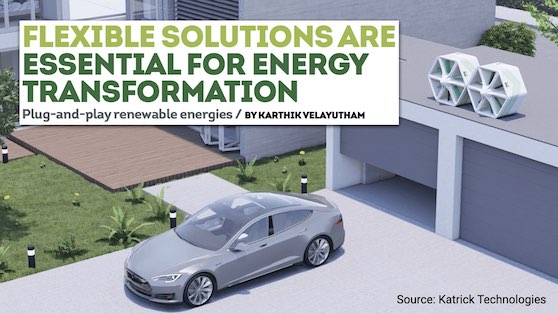
Articles
Cleantech
Features
Articles
Cleantech
Energy & Power
Generation
Profiles
Renewables
Flexible solutions are essential for energy transformation
August 22, 2023 | By Karthik Velayutham
Plug-and-play renewable energies

August 22, 2023 – The energy sector is in a state of transition as the world moves to lower-carbon power generation. Embracing sustainable resources is key to achieving environmental goals but, due to their unpredictability, generation flexibility will be key.
The International Energy Agency (IEA) Net-Zero by 2050 roadmap states that a rapid scale-up of renewable technology is needed to meet the world’s energy ambitions. The roadmap estimates we could achieve this goal with the addition of 630 GW of solar and 390 GW of wind generation every year.
But these figures aren’t actually realistic.
These levels for solar and wind are, in fact, 4x the record volume of wind and solar generation seen in 2020. Moreover, IEA admits the level of solarpower alone would require the construction of the world’s current largest photovoltaic parks every single day. (The Golmud Solar Park in China has an installed solar capacity of 2.8 GW.)
Expanding the generation capacity of existing renewable energy sites is great, but we also need to see the deployment of new renewable energy technologies.
New energy technologies
IEA’s roadmap estimates that around half of the reductions in emissions by 2050 will come from technologies that are still at the prototype or demonstration stages; new technologies that will help address some of the limitations faced by our current renewable energy sources—primarily, flexibility.
By their very nature, wind, solar, and tidal power are all unpredictable, with only a certain degree of accuracy achievable in estimating kinetic energy potential. This means that the energy flow from a renewable source can be inconsistent, unstable, and difficult to control.
Moreover, not every solution is suitable for every location; landlocked areas will not benefit from tidal power, and built-up areas present an obstacle for wind power.
Energy storage offers one solution to this challenge. While a variable supply can pose an issue in a typical grid configuration, implementing battery storage to store surplus energy can safeguard supply.
Plug-and-play generation
A growing field of green energy technology is plug-and-play systems, which are able to be used immediately upon connection, with minimal effort required. Beyond the initially installation and connection to the main grid, these systems do not require overly complex infrastructure nor large amounts of space and, because they can be installed individually and connect easily to the grid, the penetration level could be significant.
At present, the most common plug-and-play renewable energy technology is solar. In the United Kingdom, around 1.2 million (or 4.1%) of homes use the technology. However, this leaves a more-efficient source of generation—wind—largely untapped.
This is not surprising, as windpower options are currently limited by their size. Granted, small turbines for individual use do exist, but to install one large enough to power a house or business can be very costly and subject to complex planning regulations.
That’s why we have been focused on exploiting low-level and ground winds with units equipped with aerofoils that capture kinetic energy from wind at a far wider range of frequencies than regular turbines. Their modular configuration and size (around 0.9 x 0.9 m for the residential panels) allows them to be easily fitted to buildings in urban and built-up areas.
That’s our plan. The technology is currently in the prototyping stage, so planning regulations will be addressed further during the development stage and especially when the panels are commercialized.
Renewable energy is essential for reaching net-zero targets but, for this to happen, plug-and-play technologies like ours and others in development will play a vital role. Boosting flexibility and stability by improving the diversity of energy generation can help to balance energy supply with demand for clean, consistent power.
Karthik Velayutham is chief technology officer with Katrick Technologies—a cleantech startup that has designed and patented technologies to capture and convert energy from waste heat, wind, and waves into mechanical vibrations to produce carbon-free electricity.
You’ll find all Back Issues of Electrical Business Magazine in our Digital Archive.
Print this page
